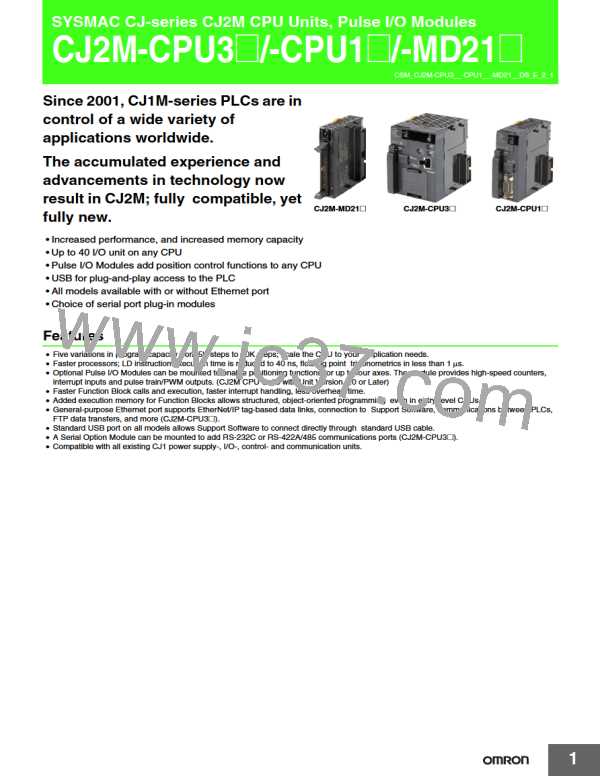CJ2M-CPU3@/-CPU1@/-MD21@
Function
Program Error Detection
Description
This function detects errors in programs.
Instruction Processing
Error Detection
This function detects an error when the given data value is invalid when executing an
instruction, or execution of instruction between tasks was attempted.
Indirect DM/EM BCD
Error Detection
This function detects an error when an indirect DM/EM address in BCD mode is not BCD.
Illegal Area Access Error This function detects an error when an attempt is made to access an illegal area with an
Detection
instruction operand.
No END Error Detection
This function detects an error when there is no END instruction at the end of the program.
This function detects an error when there are no tasks that can be executed in a cycle, there
is no program for a task, or the execution condition for an interrupt task was met but there is
no interrupt task with the specified number.
Fatal Error
Detection
Task Error Detection
Self-
diagnosis
and
Differentiation Overflow
Error Detection
This function detects an error when too many differentiated instructions are entered or deleted
during online editing (131,072 times or more).
Invalid Instruction Error
Detection
This function detects an error when an attempt is made to execute an instruction that is not
defined in the system.
Restoration
User Program Area
This function detects an error when instruction data is stored after the last address in user
Overflow Error Detection program area.
Cycle Time Exceeded Error
Detection
This function monitors the cycle time (10 to 40,000 ms) and stops the operation when the set
value is exceeded.
System FALS Error Detection This function generates a fatal (FALS) error when the user-defined conditions are met in
(User-defined Fatal Error)
program.
Fatal Error
Detection
(Continued from
previous page)
This function detects an error when a user program includes a function that is not supported
by the current unit version.
Version Error Detection
Memory Card Transfer Error This function detects an error when the automatic file transfer from Memory Card fails at
Detection
startup.
This function collectively backs up the data in CPU Unit (user programs, parameters, and I/O
memory) and internal backup data in the I/O Units.
Simple Backup Function
A function that allows the PLC to use Network Communications Instruction to send required
FINS commands to a computer connected via a Host Link
Unsolicited Communications
Host Link communications can be used for remote programming and remote monitoring
through a Controller Link, Ethernet, DeviceNet, or SYSMAC LINK Network. Communications
across network layers can be performed.
Remote Programming and Monitoring
Maintenance
Controller Link or Ethernet : 8 layers
DeviceNet or SYSMAC LINK : 3 layers
Direct
Serial
Connection
This function enables automatically connecting to the PLC online when the CX-Programmer
is directly connected by a serial connection (peripheral (USB) port or serial port).
Automatic Online Connection via
Network
Via
Networks
This function enables connecting the CX-Programmer online to a PLC that is connected via an
EtherNet/IP network.
This function protects reading and displaying programs and tasks using passwords.
Write protection: Set using the DIP switch.
Read Protection using Password
Read protection: Set a password using the CX-Programmer.
FINS Write Protection
Unit Name Function
This function prohibits writing by using FINS commands sent over the network.
Security
This function allows the users to give any names to the Units. Names are verified at online
connection to prevent wrong connection
This function sets operation protection by identifying hardware using the user programs
according to lot numbers stored in the Auxiliary Area.
Hardware ID Using Lot Numbers
12

 OMRON [ OMRON ELECTRONICS LLC ]
OMRON [ OMRON ELECTRONICS LLC ]